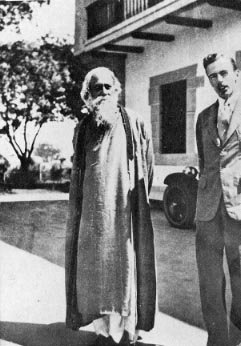Tagore was deeply dissatisfied with the system of education. Education and pedagogy therefore became Tagore’s preoccupation. He decided to found his own school in 1901, with 5 students and 5 teachers. This evolved into an entire university, which Tagore named Visva-Bharati. The Sanskrit name, as Tagore explained at the university’s inaugural ceremony in 1921, means ‘where the whole world forms its one single nest’.
The philosophy behind the university was unique. First, it would bring together knowledges from the East and West. Second, the university would connect to, and become an integral part of the community within which it was located. Tagore’s objective was to break with the traditional model of the university where the elite pursued knowledge for its own sake. Rather, a university must touch the lives of ordinary people and build a true human community where no one was marginalized. It was no accident that Tagore’s Visva Bharati was located in a village and not in a city, not amidst the urban, British-schooled affluent classes. Very close to Visva Bharati Tagore established the Institute of Rural Reconstruction, yet another institution designed specifically to serve the rural economy.
LK Elmhirst was an agricultural economist trained in Cornell University, USA who was invited by Tagore to assume the directorship of the that Tagore established. Tagore wrote to him:
I remember how you came fresh from your university and you were absurdly young, but you were not the lean academic or aridly intellectual. With your instinctive humanity you came into the closest touch with the living being which is the village, and which is not a mere intellectual problem that could be solved through the help of arithmetical figures. I have personal experience of scientists who think that they know human facts, without taking the trouble to know the man himself. It is not for them to create and not even to construct, they never have done it though they help. You had human sympathy in abundance, which was the principal motive power that carried you across all the difficulties that stood against you in their congregated might. You rightly named your work Village Reconstruction Work for it was a living work comprehending village life in ah its various activities, and not merely productive of analytic knowledge.
In 1923, Elmhirst accompanied Tagore on his travels around India, and travelled to America and the United Kingdom. In 1924 Tagore asked him to accompany him on a mission to China and Japan.
The book is a record of Elmhirst’s interactions with Tagore and in particular, Tagore’s views about education. Click here for full text.
Warning: Invalid argument supplied for foreach() in /home2/ananya/public_html/wp-content/themes/suffusion/comments.php on line 21
3 Responses to “Tagore as a pioneer in education, by L.K.Elmhirst”
Sorry, the comment form is closed at this time.

The website is really interesting, I could not stop reading, the summaries are just right (not too short, not too long), the language is accessible, the only suggestion I have would be to maybe add some of his drawings throughout for visual interest. I have been looking for inspiration to write my teaching philosphy, I
definitely found it!
Exactly what is While in the FUTURE?
…For further Information click here…
[...]Wow, incredible blog format! How long have you been blogging for?[...]…